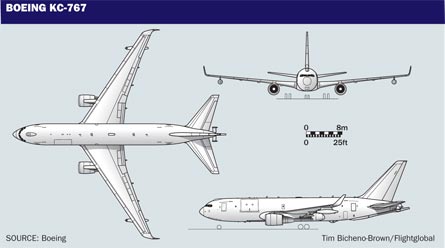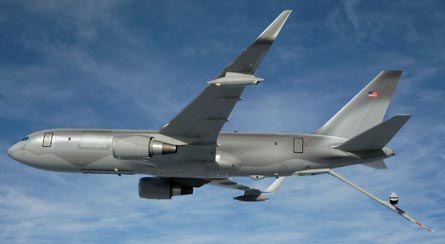Since losing the first competition for KC-X, Boeing has retained the same basic type model series in its proposal, but changed virtually everything else about its marketing approach and product offering.
The KC-767 NewGen Tanker, unveiled in a low-key announcement on 4 March, fills in a few essential details, but leaves the most important elements of Boeing's proposal shrouded in mystery.
Such pre-submittal secrecy is normal in the aerospace industry, but the practice contrasts sharply with Boeing's approach in the previous competition. Flush with the confidence of being the US Air Force's incumbent tanker supplier for a half-century, the company spared few details about its proposal in the months before the release of the previous request for proposals.
|
|---|
Jean Chamberlin, newly-appointed KC-767 programme manager, explained in a February interview that she foresaw a tough competition. "I do see it as neck and neck," Chamberlin said. "This is a really tough competition. I'm going to have a hard time thinking about how much [information] I'll disclose now."
Boeing has also launched a very different marketing campaign. If company executives lectured air force officials about refuelling concepts in the first round, they have resisted that urge in the second contest. Instead, Boeing officials have repeatedly stressed that they would listen to the customer's requirements, and respond with the best aircraft the company can offer.
Until the 4 March announcement, Boeing officially was considering either the KC-767 or KC-777, although it conceded that the KC-767 became more likely after the air force issued a draft list of requirements in September calling for a smaller aircraft.

When the KC-767 NewGen Tanker was revealed, however, it was clear that Boeing had decided to offer a very different and more sophisticated tanker to the air force.
A 787-style digital flight deck featuring four 15.1in liquid crystal displays would be integrated on the 767 if Boeing wins the contract. The cockpit also shows two cursor control devices on the instrument panel, similar to the cockpit layout inside the 777. However, the design lacks a fifth multi-function display, as offered on the 787.
The most visible change to the KC-767 airframe are newly-added winglets, as the air force now stipulates a preference for the most fuel efficient aircraft. The new design also incorporates an improved refuelling boom system, which extends from the belly of the centre fuselage. The new boom includes a wider refuelling envelope, Boeing says, and digital control technology.
But there remain significant gaps in the public knowledge about the KC-767. In the previous round, Boeing's offering was sometimes criticised by its opponents as the "Frankentanker". The aircraft was a composite, including the fuselage of the -200, wings of the -300 and cockpit of the -400ER. So far it's not clear which of Boeing's aircraft contribute to the NewGen Tanker's structures and flight control systems. In any event, Boeing is not asking its propulsion supplier to provide any additional power. Pratt & Whitney will deliver the same 62,000lb (275kN) thrust PW4062 engines as offered in the previous competition. The selection of the PW4062, however, does not tip Boeing's hand, as the engine powers all three variants of the 767.
BOEING'S NEWGEN OFFERING BREAKS AWAY FROM LEGACY
Boeing's proposed NewGen Tanker design incorporates numerous major advances over the 767-200-based aircraft already sold to export customers Italy and Japan.
The nations have each ordered four General Electric CF6-80C-engined KC-767s, all in the convertible freighter configuration. This enables them to also fly the aircraft carrying either a full load of cargo, up to 200 passengers or a combination of both.
Japan's air force early this year received its last boom-equipped example from Boeing's local partner Itochu. Deliveries had started in 2008, and the type was placed into operational service at its Komaki air base last July.

Italy's acquisition has been less straightforward, with its air force now expecting to put the KC-767A into frontline use from later this year.
Originally scheduled for delivery from 2007, the model has encountered development delays with key equipment including its Smiths Aerospace hose and drogue refuelling pods. Its aircraft are also equipped with a Boeing tail boom and a centreline hose drum unit. The problems also prompted the company to remove its local conversion partner, Aeronavali, from the project in an attempt to reduce delays.
The configuration selected by Italy has a maximum fuel capacity of 92,000kg (203,000lb), with this having been increased from the design's original 73,000kg limit through the addition of three auxiliary tanks each in the aircraft's forward and aft cargo bays.
The Italian air force is currently using one passenger-configured 767-200 to support training activities for its tanker crews. Boeing is now working to complete certification activities in the USA. "Three of the four tankers are in flight test, with the fourth airplane still being modified," it says.
Additional reporting by Craig Hoyle
Source: Flight International

















